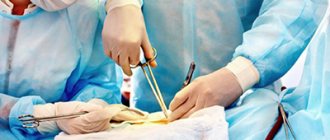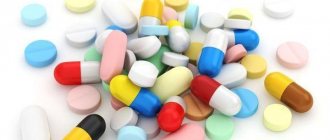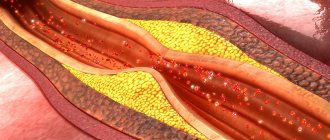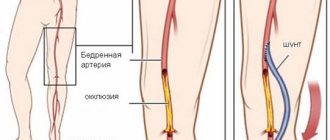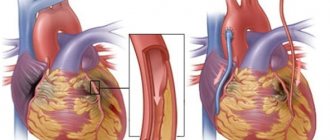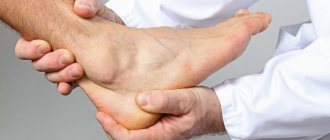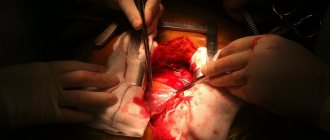Early postoperative period
Wound care. Typically, postoperative sutures do not require removal, and the wound does not require special care. The doctor may recommend that you treat the wound with brilliant green for several days, in most cases this is enough. However, you need to protect the wound from injury, avoid rubbing the wound with clothing, and avoid hypothermia.
Shower. If sutures are not required or are removed, you can shower. Hot showers are not recommended. The wound is washed with warm water without using a washcloth. After washing, you need to blot the wound area with a towel, do not rub! After the wound has dried, you can treat it with brilliant green.
Mode. During the first month after surgery, a gentle regime is necessary. The wound must heal, and the body “get used” to the new features of the blood supply. Therefore, physical activity, baths, saunas, hypothermia are not recommended, and alcohol intake should be completely avoided.
Medicines. After the operation, you will be prescribed medications. Strictly follow the regimen and dosage. More information about medications will be discussed below.
Essence, indications and contraindications
Attention! Only your attending physician will give you health recommendations that are relevant to you. The article contains only general information that will help you navigate the problem.
As a rule, the operation is performed when the patient’s coronary bed is affected by 75% or more, and angina pectoris is resistant to medications.
During the operation, an additional path is created for blood flow to the heart, bypassing the arteries affected by atherosclerosis. The donor of shunts, vascular grafts, is the patient himself - they are taken from the internal mammary artery, the great saphenous vein in the leg or the radial artery in the arm. The duration of the operation depends on the number of affected arteries - on average, 4-5 hours.
Also, before surgery, it is necessary to take into account such risk factors as:
- diffuse lesions of all coronary arteries
- heart failure and kidney failure
- scarring and decreased performance of the left ventricle by more than 30%
- oncological diseases
- chronic nonspecific lung diseases: bronchitis, pneumonia, asthma, emphysema
What to do to avoid repeated operations?
Most people know what a healthy lifestyle is, that smoking, overeating and lack of exercise are harmful to health. Following simple rules (see the article “Prevention of Atherosclerosis”), which should become a habit, will help not only to avoid repeated operations, but to maintain health for many years.
Lifestyle
An active lifestyle is very important, not only for the prevention of atherosclerosis, but for maintaining health in general.
It is important for post-surgery patients to choose the right type of exercise. This is primarily walking, doing housework, gardening, or climbing stairs. You can work out in the gym (physical therapy), swim. But it is important to remember that exercise associated with heavy sweating (when you sweat a lot) is undesirable. If they are unavoidable, always keep a water bottle with you.
Diet
It is necessary to form the habit of healthy eating. Changing your diet is essential to normalize your weight and reduce your cholesterol levels, which play a huge role in plaque formation.
Medications
Taking medications after arterial surgery is extremely important. This should become a daily habit. In order not to forget to take a pill, you can use, for example, a reminder on your phone.
The main medications that need to be taken after artery surgery are “blood-thinning” drugs (antiplatelet agents and anticoagulants). Taking these medications will help avoid thrombosis of the reconstruction area. Therefore, strictly follow the dosage regimen and dosage. Under no circumstances should you stop taking these medications on your own. However, taking “blood-thinning” drugs can provoke various bleedings (nasal bleeding, menstrual bleeding, bleeding gums, spontaneous formation of hematomas, and so on). If signs of bleeding appear, you should immediately consult a doctor. If you see another doctor, such as a dentist or gynecologist, be warned about taking “blood-thinning” medications.
To prevent further development of atherosclerosis, drugs are prescribed to lower cholesterol levels ().
Bath, sauna
The steam room is not recommended for patients after arterial surgery, especially in combination with alcohol. The fact is that in the steam room a person sweats and loses a lot of fluid, which leads to “thickening” of the blood and can provoke the formation of a blood clot, especially in the operation area. The same applies to any situations in which increased sweating occurs (physical activity, hot weather, etc.). If such situations are unavoidable, always keep a water bottle with you.
Alcohol
Excessive alcohol consumption is a risk factor for the development of thrombosis of various locations, even in a healthy person. As for the patient after arterial surgery, alcohol abuse greatly increases the risk of developing thrombosis of the arterial reconstruction zone. Most patients with atherosclerosis after artery surgery completely refuse to drink alcoholic beverages.
Visit doctor
Regular visits to the doctor and additional research methods (blood tests, ultrasound, etc.) will help avoid unfavorable situations.
Don't neglect your health.
Visit your doctor regularly and follow all his recommendations.
Memo to the patient during coronary artery bypass surgery
We consider it necessary, before coronary bypass surgery, to present you with an abbreviated version of the manual for a patient who is about to undergo coronary bypass surgery. It gives very important advice on many issues regarding your upcoming operation.
The manual briefly presents tips and tricks, the use of which will provide you with a calmer and more effective passage of the postoperative period, and will help you avoid many mistakes and incorrect actions that are fraught with complications. You will also need this manual later after the operation to improve the long-term results of the operation.
With wishes for a speedy recovery!
To train the respiratory muscles, along with the use of breathing exercises, various breathing simulators can be used, as well as improvised means, such as a tube, a balloon, a rubber bladder.
When using them, it is recommended to blow into a tube, inhale as deeply as possible, and exhale as long as possible, timing the exhalation time. During subsequent exercises, try to increase the exhalation time. In addition, breathing through a tube can be done in the following way: inhale in 3-4 small breaths, as if in portions, and exhale calmly evenly; or inhale evenly and deeply, and exhale in portions into a tube.
When using special simulators, you should consult with your doctor about the possibility of use, and if approved, follow the instructions included with this simulator.
One of the very important points in the preoperative period is the acquisition of abdominal breathing skills , which you will need in the early postoperative period for easier full breathing, improved gas exchange and good discharge of sputum from the lungs:
- I.p. – lying on the bed or sitting on a chair, one hand lies on the stomach, the other on the chest, the body is relaxed: take a calm breath through the nose, inflating the stomach, while the hand lying on the stomach rises, and the second one, on the chest, remains motionless .
- The duration of inhalation is 2–3 s. When you exhale through a half-open mouth, the stomach drops. The duration of exhalation is 4–5 s.
- After exhaling, there is no need to rush to inhale again, but should pause for about 3 seconds until the first desire to inhale appears.
- During one lesson, you need to perform from 5 to 10 repetitions, at least 4-5 approaches (times) per day. If you are a smoker, it is very important to stop smoking as soon as possible before surgery. Every day and even an hour before anesthesia that you spend without a cigarette will reduce the likelihood of lung problems that arise after surgery. Quitting smoking will significantly improve the long-term results of the operation: coronary bypass grafts formed during the operation will work for many years and will relieve you of heart pain and other problems with your health. Remember that if you continue to smoke, you may significantly reduce the effectiveness of your surgery.
If your operation is scheduled for the next morning, you will not be allowed to drink or eat after 20:00, if in the afternoon, you will be allowed to eat some liquid food early on the morning of the operation. On the day of surgery, be sure to take all medications prescribed by your doctor and drink them with the minimum required amount of water.
Another serious complication in the postoperative period is suppuration of the postoperative wound. To prevent this complication, you need to wash with soap in the evening (it reduces the number of bacteria on the skin, thereby reducing the risk of infection).
It is necessary to remove hair on the day of surgery from where the incisions are planned (from the chest, from the legs from the feet to the groin and from the groin area), using electrolysis or using depilatories. When using depilatories, to avoid an allergic reaction, apply a small amount of cream to the inside of the forearm the night before; if there is no redness (allergic reaction), you can apply it to the desired area. Avoid shaving the skin in the area of surgery, as shaving causes microdamage to the skin and the possible formation of pustules - micropustules, which is a very good environment for the development of bacteria.
Before the operation, you will definitely need to ensure that you have a postoperative bandage (corset) for the chest and, possibly, elastic bandages for bandaging the legs. The corset (bandage) is designed to prevent the divergence of the two halves of the cut sternum, and elastic bandages are designed to cover the wound of the leg after taking your vein from it, which will serve you to supply blood from the aorta to the muscle of your heart. Place the corset and elastic bandages in your personal belongings so that you can easily get them out and start using them as soon as you are transferred from the intensive care unit to the recovery room.
Before the operation begins, doctors will connect special tubes (catheters) to you. This is necessary to continuously monitor your vital signs during and immediately after surgery. Catheters are inserted into arteries and veins after you fall asleep.
After operation. When you wake up after surgery, you will find a breathing tube in your mouth connected to a respirator. Under no circumstances should you grab it or try to pull it out. A respirator will help you breathe until you can do it on your own. Once the breathing tube is removed, you will be able to breathe deeply and
cough to remove mucus from the lungs.
There is no need to be afraid of coughing; thanks to it, accumulated phlegm is removed from the lungs. But for normal healing of a postoperative wound, it is necessary to protect the sternum and shoulder girdle from excessive stress. Therefore, you need to cough correctly. Remember that when coughing, the post-operative bandage (corset) must be properly fastened to your chest.
When coughing, you need to clasp your shoulders with your hands and fix your chest, and perform coughing movements using your abdominal muscles, trying to keep your chest motionless. This is where belly breathing comes in handy. To properly support the chest when coughing, it is convenient to use a pillow, pressing it tightly to the chest, as if hugging it.
If there is no means at hand, you can fix the chest with your palms.
How to stand up correctly. After surgery, the process of getting out of bed is the most difficult and difficult for the body. Even walking during this period is an easier process. Therefore, you need to get up for the first time with the help of medical personnel. Remember that stress on the shoulder girdle when standing is unacceptable, as it may have a negative effect on the healing of the sternum. If you lean on your hands or pull yourself up with your hands when standing up, the sutures on the sternum may become loose, which can lead to a serious complication, i.e. divergence of the sternum.
Before getting up, do not forget to fasten your corset and follow certain rules. When rising, you need to roll onto your side and then lower your legs from the bed, using your upper torso and arms to try to sit up.
Don’t rush to get to your feet right away; first, try pressing your feet on the floor one at a time, as when walking, and only then get up. You cannot lean on your back with two elbows, turn on your side without lowering your legs to the floor.
How to walk correctly. After you gain confidence in your legs, and this happens quickly, you need to walk, but little by little, much less than before the operation. On the 1st day after surgery, it is better to only walk around the room.
If your condition is more stable the next day and you are able to sit up in a chair, you can walk around the room for a short distance. You will be transferred to an inpatient ward, where you will continue to be monitored.
In the inpatient department. In the department, your activity will increase every day. On the 1st day after transfer from the intensive care unit, it is better to walk around the ward. The next day you can go out into the corridor. Your task is to walk little by little, without any unpleasant sensations in the chest. For some this distance will be 5 m, for others it will be 50 m, but at one time it should not exceed 150 m. During the day you can walk from 1 to 15 times. Focus on your well-being. You should continue to do breathing exercises and belly breathing to stimulate coughing. Remember to keep a pillow nearby and use it when you cough. You need to continue the exercises you started in the intensive care unit for your arms, legs and chest.
Getting up from a chair: move to the edge of the chair, place your feet under you, try to stand up using your leg muscles.
Sitting: Sit up straight with both feet on the floor. Your knees should be level with your hips. Don't cross your legs.
Lifting objects from the floor: without bending at the waist, bend your knees, lowering your body vertically; your back should remain straight.
In order to prevent sternum divergence in the first 2–3 months, it is not recommended:
- in a lying position, place your hands behind your head;
- spread your arms in different directions;
- move your hands behind your back (in different positions);
- cross your arms in front of you;
- raise both arms up;
- perform exercises with both hands;
- move around the bed, leaning with both hands;
- in a lying position, raise your legs up;
- in a lying position, perform the “bicycle” exercise;
- bend the body forward, sideways, backward, and rotate the body;
- sleep on your stomach or side;
- pull up;
- perform push-ups (even from the railing).
Tips for breast corset:
- The corset is worn over underwear made of cotton fabric and does not irritate the postoperative seam. It is strictly not recommended to wear it on a naked body!
- The corset should be worn while lying on your back.
- The postoperative corset is worn around the clock for up to 3 months after surgery.
- A break from wearing a corset is a must. Unfasten the Velcro or hooks periodically for 15–20 minutes. Making sudden movements at such moments is strictly prohibited!
- Remember that the corset must be fastened tightly enough to keep the breastbone stationary and heal well. Take as deep a breath as possible, then fasten the corset tightly.
Fully or partially limited products
All types of fatty meat, bacon, lard, any sausages, pates and meat pastes, as well as offal - liver, heart, brains - should be excluded from the diet. Broths containing meat, mushrooms and fish are prohibited. All fried foods, animal and cooking fats, mayonnaise and margarine are completely excluded from the diet. The consumption of butter, high-fat dairy products (sour cream, cream), and cheese is limited. Consumption of chicken eggs is limited to 3-4 eggs per week. You should not include fish and crustacean caviar, fatty fish (sprats, sardines) in your diet.
From the list of products you need to cross out white bread, confectionery, ice cream, carbonated drinks, as well as sugar and products containing it, honey. It is recommended to replace sweets with dried fruits. The restriction also applies to products with a high salt content (pickles, canned food, smoked meats). After vascular surgery, the consumption of chicken egg yolks, products made from butter/puff pastry, rice, semolina, pasta, as well as products containing a lot of caffeine (chocolate, strong tea, coffee, cocoa), which cause vasospasm and increase heart disease, is completely prohibited. activity. The consumption of sweet carbonated drinks, raisins, grapes, various spices and all types of alcoholic drinks is not allowed.
Table of prohibited products
| Proteins, g | Fats, g | Carbohydrates, g | Calories, kcal | |
Fruits | ||||
| bananas | 1,5 | 0,2 | 21,8 | 95 |
Berries | ||||
| grape | 0,6 | 0,2 | 16,8 | 65 |
Nuts and dried fruits | ||||
| raisin | 2,9 | 0,6 | 66,0 | 264 |
Cereals and porridges | ||||
| semolina | 10,3 | 1,0 | 73,3 | 328 |
| white rice | 6,7 | 0,7 | 78,9 | 344 |
Flour and pasta | ||||
| pasta | 10,4 | 1,1 | 69,7 | 337 |
Bakery products | ||||
| bagels | 16,0 | 1,0 | 70,0 | 336 |
| bagels | 16,0 | 1,0 | 70,0 | 336 |
| crackers | 11,2 | 1,4 | 72,2 | 331 |
Confectionery | ||||
| jam | 0,3 | 0,2 | 63,0 | 263 |
| jam | 0,3 | 0,1 | 56,0 | 238 |
| candies | 4,3 | 19,8 | 67,5 | 453 |
| pastry cream | 0,2 | 26,0 | 16,5 | 300 |
Ice cream | ||||
| ice cream | 3,7 | 6,9 | 22,1 | 189 |
Cakes | ||||
| cake | 4,4 | 23,4 | 45,2 | 407 |
Chocolate | ||||
| chocolate | 5,4 | 35,3 | 56,5 | 544 |
Raw materials and seasonings | ||||
| ketchup | 1,8 | 1,0 | 22,2 | 93 |
| mayonnaise | 2,4 | 67,0 | 3,9 | 627 |
| honey | 0,8 | 0,0 | 81,5 | 329 |
Dairy | ||||
| cream | 2,8 | 20,0 | 3,7 | 205 |
| sour cream 30% | 2,4 | 30,0 | 3,1 | 294 |
| sour cream 40% (fat) | 2,4 | 40,0 | 2,6 | 381 |
Cheeses and cottage cheese | ||||
| cheese | 24,1 | 29,5 | 0,3 | 363 |
| cottage cheese 18% (fat) | 14,0 | 18,0 | 2,8 | 232 |
Meat products | ||||
| pork | 16,0 | 21,6 | 0,0 | 259 |
| pork liver | 18,8 | 3,6 | 0,0 | 108 |
| pork kidneys | 13,0 | 3,1 | 0,0 | 80 |
| pork fat | 1,4 | 92,8 | 0,0 | 841 |
| salo | 2,4 | 89,0 | 0,0 | 797 |
| beef liver | 17,4 | 3,1 | 0,0 | 98 |
| beef kidneys | 12,5 | 1,8 | 0,0 | 66 |
| beef brains | 9,5 | 9,5 | 0,0 | 124 |
| mutton | 15,6 | 16,3 | 0,0 | 209 |
Sausages | ||||
| smoked sausage | 16,2 | 44,6 | 0,0 | 466 |
| smoked sausage | 9,9 | 63,2 | 0,3 | 608 |
| sausages | 10,1 | 31,6 | 1,9 | 332 |
| sausages | 12,3 | 25,3 | 0,0 | 277 |
Bird | ||||
| smoked chicken | 27,5 | 8,2 | 0,0 | 184 |
| duck | 16,5 | 61,2 | 0,0 | 346 |
| smoked duck | 19,0 | 28,4 | 0,0 | 337 |
| goose | 16,1 | 33,3 | 0,0 | 364 |
Eggs | ||||
| chicken eggs (yolk) | 16,2 | 31,2 | 1,0 | 352 |
Fish and seafood | ||||
| smoked fish | 26,8 | 9,9 | 0,0 | 196 |
| salted fish | 19,2 | 2,0 | 0,0 | 190 |
| Red caviar | 32,0 | 15,0 | 0,0 | 263 |
| black caviar | 28,0 | 9,7 | 0,0 | 203 |
| squid | 21,2 | 2,8 | 2,0 | 122 |
| salmon | 19,8 | 6,3 | 0,0 | 142 |
| sturgeon | 16,4 | 10,9 | 0,0 | 163 |
| canned fish | 17,5 | 2,0 | 0,0 | 88 |
| semi-finished fish products | 12,5 | 6,7 | 14,7 | 209 |
| sardine | 20,6 | 9,6 | — | 169 |
| mackerel | 18,0 | 13,2 | 0,0 | 191 |
| cod (liver in oil) | 4,2 | 65,7 | 1,2 | 613 |
Oils and fats | ||||
| butter | 0,5 | 82,5 | 0,8 | 748 |
| creamy margarine | 0,5 | 82,0 | 0,0 | 745 |
| coconut oil | 0,0 | 99,9 | 0,0 | 899 |
| palm oil | 0,0 | 99,9 | 0,0 | 899 |
| rendered beef fat | 0,0 | 99,7 | 0,0 | 897 |
| cooking fat | 0,0 | 99,7 | 0,0 | 897 |
| rendered pork fat | 0,0 | 99,6 | 0,0 | 896 |
Alcoholic drinks | ||||
| white dessert wine 16% | 0,5 | 0,0 | 16,0 | 153 |
| dry white wine | 0,1 | 0,0 | 0,6 | 66 |
| vodka | 0,0 | 0,0 | 0,1 | 235 |
| cognac | 0,0 | 0,0 | 0,1 | 239 |
| liquor | 0,3 | 1,1 | 17,2 | 242 |
| beer | 0,3 | 0,0 | 4,6 | 42 |
Non-alcoholic drinks | ||||
| cola | 0,0 | 0,0 | 10,4 | 42 |
| black coffee | 0,2 | 0,0 | 0,3 | 2 |
| Pepsi | 0,0 | 0,0 | 8,7 | 38 |
| sprite | 0,1 | 0,0 | 7,0 | 29 |
| tonic | 0,0 | 0,0 | 8,3 | 34 |
| black tea | 20,0 | 5,1 | 6,9 | 152 |
| * data is per 100 g of product | ||||
Diet after valve replacement
Middle-aged and elderly patients, especially those with coronary heart disease, are advised to follow a special diet. It is necessary to reduce the content of animal fats and easily digestible carbohydrates in the diet, as well as reduce the consumption of table salt, coffee and other stimulants. At the same time, you should enrich your diet with vegetable oils, fresh vegetables and fruits, fish and protein products.
Young patients who do not have atherosclerosis and its complications may not be so strict about their diet, although it is best for them to formulate a diet in accordance with the canons of a healthy diet - to prevent IHD.
Excessive alcohol consumption is contraindicated in all patients after heart valve replacement.
Principles of a balanced diet after bariatric surgery
It is important to remember that bariatric surgery is surgery on the gastrointestinal tract. It changes the functioning conditions of the digestive system, and nutrition after surgery has some features. Your doctor will provide you with an individual diet plan.
General recommendations to follow:
- Protein is the main component of the diet. You must consume at least 60 g of protein per day. It is found in sufficient quantities in meat (turkey breast, chicken, fish fillet, beef, pork), low-fat cheese, cottage cheese, eggs, and peanut butter.
- Don't skip meals. Frequent, small meals will prevent stomach overfilling and improve metabolic processes.
- Eat only at the dinner table, do not rush.
- Place small portions on plates. Cut food into small pieces and chew thoroughly and slowly. Use small dishes and baby spoons to avoid overeating. Stop as soon as you feel full.
- Drink more fluids throughout the day (6-8 cups). Avoid carbonated, high-calorie drinks and caffeine. Drink at intervals of 30 minutes before or after meals, this will help prevent nausea and vomiting.
- Take a daily vitamin and mineral supplement (multivitamin, calcium citrate), but check with your doctor first. Additionally, vitamins B12, D, and iron may be required.
Remember that a balanced diet after bariatric surgery is not just a diet, but a new way of life. In order to lose weight, healthy habits must become an integral part of your life.
Reviews and results
As evidenced by medical practice and reviews from most patients, dietary nutrition after bypass surgery and testing of heart vessels is the most important component of the treatment process and the prevention of further progression of atherosclerosis.
- “... At the age of 65 I was admitted to cardiology with acute coronary syndrome. We did stenting, a regular metal stent (Multi-Link VISION). There were no complications. The only medications prescribed were Plavix, Cardiomagnyl and Egilok. Cholesterol is 5.3, they prescribed an anti-cholesterol diet, which, according to doctors, I need to follow for life. And now I’ve been sitting on it for more than 6 months. I don’t feel any particular inconvenience, since there are many permitted foods in the diet”;
- “... After stenting the coronary vessels (4 stents) 3 years ago, the lipid profile is still unsatisfactory. For normalization, strict therapeutic nutrition was recommended. I followed this diet immediately after the operation, but then I relaxed and began to break it. Now I’m starting to eat again on the doctor’s recommendation, I hope it will help.”
Physical activity after valve replacement
Often, patients are sent for valve replacement if, before surgery, there were manifestations of chronic heart failure, which impair exercise tolerance and do not allow patients to move freely and actively.
The operation improves well-being, but patients often have no idea whether they can increase the load, in what specific mode to do this and to what limits. To determine the exercise regime, it is best for the patient to undergo a rehabilitation program in a sanatorium. An individual set of physical exercises will be selected for him, which he will perform under the supervision of a doctor. Gradually, taking into account the dynamics, the motor mode will expand. As a result, by the end of the rehabilitation period, a person will be able to live a full active life, freely endure everyday and other stresses.
If the patient does not plan to undergo rehabilitation in a sanatorium, he should contact a cardiologist with questions related to physical activity. You can clarify any questions with your doctor: the ability to engage in certain sports, lift weights, drive a car, etc.
In the first weeks, during the recovery period after surgery, it is very important to control the degree of stress. It is necessary to be active to such an extent that, on the one hand, it does not overload the heart, and on the other, does not slow down recovery and does not contribute to the development of complications.
Some patients move little because planning loads and performing exercises require discipline, diligence, and effort. Those who are too lazy to exercise should remember that physical activity improves the prognosis of heart disease, trains the cardiovascular system, has a general healing effect and helps to achieve better results from the operation.
Work after valve replacement
Within a few weeks after surgery, patients usually manage to restore their ability to work at their previous level. In some cases, a transition to easier working conditions is required. Sometimes patients are given a disability group.
The above formulations are quite streamlined, but it is impossible to give specific figures here. Much depends on which valve was prosthetized, what type of artificial valve was, in connection with what disease the operation was performed, and in what field the person is employed.
In general, the forecast for work activity is favorable. Even professional athletes returned to sports after this surgical intervention and successfully continued their careers.
